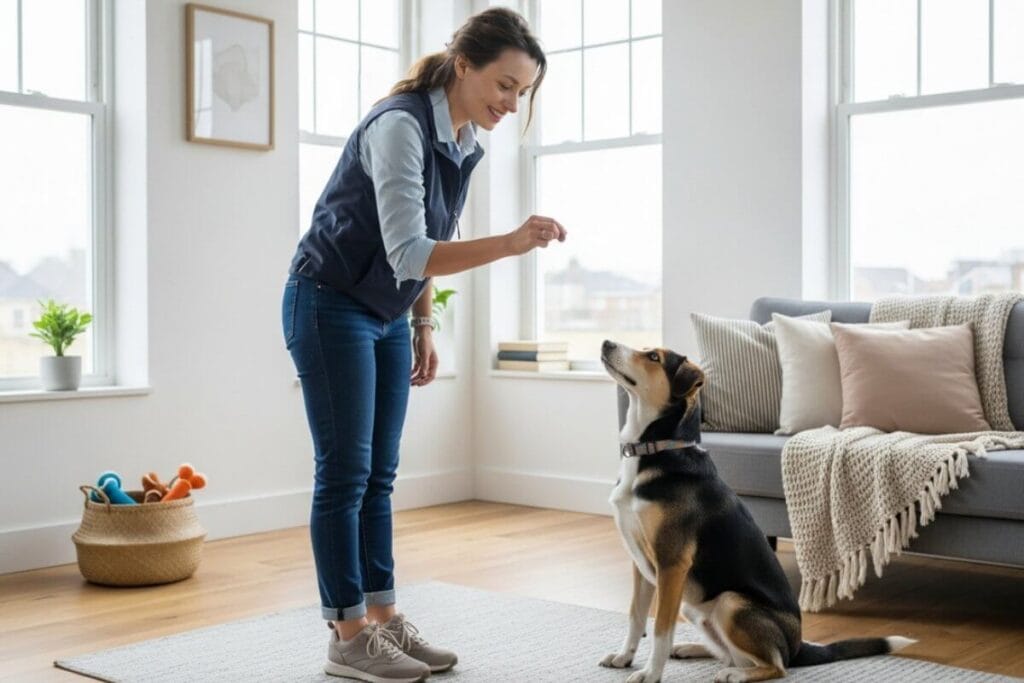The endless barking, the complaints from neighbors, the feeling of being at your wit’s end… I get it. You’re searching for a stop dog barking device that will bring peace and quiet, right now. The promise of a quick fix from an ultrasonic device or anti-bark collar is incredibly tempting when you’re feeling desperate.
But before you click “buy,” let’s talk about a secret the best trainers know: most of those devices fail because they only silence the symptom, not the cause. Punishing a bark is like putting tape over a flashing check engine light. It doesn’t fix the underlying problem. This guide will show you the humane alternatives that veterinarians and certified trainers recommend to actually solve the root problem for good.
Smarter Paws Academy is reader-supported. When you buy through links on our site, we may earn an affiliate commission at no extra cost to you. As an Amazon Associate, I earn from qualifying purchases. Thank you for your support!
Important Health Disclaimer
The information in this article is for educational purposes only and is based on my personal and professional experience as a certified dog trainer. It is not a substitute for professional veterinary advice. Please consult your veterinarian to diagnose any health issues and before making any significant changes to your dog’s diet.
Key Takeaways: Stop Dog Barking Devices
- Root Cause: Most anti-bark devices only silence the symptom, not the cause. Understanding why your dog barks is the first step to solving the problem.
- Types of Barking: Most nuisance barking falls into three categories: boredom, fear/alert, and anxiety. Each requires a different solution.
- Humane Solutions: Instead of punishment, use enrichment toys for boredom, environmental management for alert barking, and calming aids for anxiety.
Prefer to Listen? An Audio Overview
For a conversational deep dive into this topic, press play below for the complete audio discussion.
Runtime: 1:26
View Full Audio Transcript
Narrator: Welcome to the Smarter Paws Academy audio overview. Today we’re tackling a search that many frustrated owners make: for a “stop dog barking device.” Sandie, what’s the first thing people should know before they buy one?
Sandie: The most important thing to know is that most of those devices—especially the ultrasonic or shock-based ones—are like putting a piece of tape over a check engine light. They might stop the noise for a moment, but they don’t fix the real problem, and they often work by causing fear or discomfort, which can create new issues like anxiety.
Narrator: So if those devices aren’t the answer, what do you recommend?
Sandie: Instead of punishing the bark, we need to understand why your dog is barking. Is it boredom? Fear of the mail carrier? Anxiety when left alone? The article walks through how to identify the root cause.
Narrator: And once you know the cause, what are the humane “devices” that actually work?
Sandie: The best tools are ones that solve the underlying need. For a bored dog, a puzzle toy is the perfect “device” because it gives them a job. For a dog that barks at everything outside, decorative window film is a simple tool that removes the trigger. We’re solving the problem, not just silencing the symptom.
Narrator: So the goal is to build a quieter home by understanding your dog better.
Sandie: Exactly. It’s about building a stronger, more trusting bond. That’s the real secret to a peaceful home, and it’s far more effective than any quick-fix gadget.
Table of Contents
Do Anti Bark Devices Really Work? The Honest Truth
This is the most common question, and the answer is complex. Yes, a shock or ultrasonic device might startle your dog into silence temporarily. But they “work” through punishment, which comes with significant risks. I once worked with a lovely family whose Beagle, “Cooper,” had started growling at them. They couldn’t understand why until we discovered that the ultrasonic anti-bark device they were using would go off whenever the mail carrier came, which was also when they would walk into the room. Cooper had learned that his owners’ presence predicted a painful sound. We threw out the device, and through positive reinforcement, we were able to rebuild that broken trust.
Cooper’s story is a perfect example of “behavioral fallout.” As the American Veterinary Society of Animal Behavior (AVSAB) states, punishment-based methods can cause serious new problems like:
- Increased Anxiety: The dog doesn’t understand why they are being punished, leading to a constant state of stress.
- Fear and Mistrust: Your dog may associate the punishment not with their bark, but with you, damaging your bond.
- Aggression: A dog that is punished for barking out of fear may eventually feel they have no other option but to bite to make the scary thing go away.
True success comes from understanding why your dog is barking and addressing that need, not just suppressing the noise.
What Do Vets Recommend to Stop Dogs From Barking?
Veterinarians and certified trainers agree: the first step is to become a “bark detective.” Barking is communication. To solve nuisance barking, we must first figure out what our dog is trying to tell us. Most barking falls into one of three categories:
1. Boredom & Lack of Enrichment
This is the “I have nothing to do!” bark. It’s often repetitive and rhythmic. Your dog is essentially telling you they need more mental stimulation and a productive outlet for their energy.
2. Fear & Alert Barking
This is the “Someone’s there!” bark. It’s typically sharp and loud, triggered by sights (the mail carrier) or sounds (a car door slamming). Your dog is acting as your alarm system.
3. Anxiety & Loneliness
This is the “I’m scared to be alone!” bark. It often happens when you leave and is a symptom of separation anxiety. This is frequently the cause when a neighbor’s dog is barking all the time.
Humane Devices & Tools That Actually Solve the Problem
Instead of a single “stop barking device,” a truly effective solution is a toolkit of humane products that address the root cause of the barking. Here are the tools I recommend based on why your dog is barking.
For the Bored Barker: The Enrichment Toolkit
These “devices” give your dog a fun, productive job, which reduces the need to bark for attention or out of boredom.

This is my top recommendation for boredom barking. It’s a “device” that gives your dog a fun, rewarding job working for their food. A mentally tired dog is a quiet dog.
For dogs who bark when they need to settle, a long-lasting chew is a perfect solution. These are a safe and digestible alternative to rawhide that keeps a dog happily occupied.
For the Alert Barker: The Environmental Management Toolkit
These tools work by removing the triggers that cause your dog to bark. This is often the most effective and humane solution for dogs that bark at windows and noises, and it’s a kind suggestion for a neighbor whose dog barks constantly.
For dogs that bark at every little sound outside, this is a game-changer. It creates a consistent, soothing ambient sound that masks the triggers, teaching your dog there’s nothing to alert you to.
This is the simplest and most effective tool for dogs that bark at people or dogs walking by. It obscures the view so the trigger is gone, but it still lets in the light. Problem solved.
For the Anxious Barker: The Calming Toolkit
These tools help reduce the underlying anxiety that can lead to stress-related barking, especially when dogs are left alone.
If your dog’s barking is rooted in anxiety, this is a must-have. It releases a vet-recommended pheromone that mimics a mother dog’s calming signals, helping to reduce stress without medication.
What to Do Instead: Teach the “Quiet” Command
While management tools are working, you can also teach your dog a positive alternative to barking. Here’s a simple way to teach “Quiet”:

- When your dog starts barking, let them bark two or three times.
- Calmly approach them, show them a high-value treat, and say “Quiet” in a calm, firm voice.
- The moment they stop barking to sniff the treat, praise them (“Yes! Good quiet!”) and give them the treat.
- Repeat this consistently. Over time, your dog will learn that the word “Quiet” means they will get a reward for stopping their barking.
This positive method teaches your dog what you want them to do, which is always more effective than punishing what you don’t want.
Are Ultrasonic Bark Deterrents Cruel?
This is a critical question. While ultrasonic devices don’t cause physical pain like a shock collar, they are still considered aversive tools. They work through “positive punishment” which adds an unpleasant, high-frequency sound to stop a behavior. As the experts at the University of Illinois College of Veterinary Medicine explain, the fallout from these tools is significant. Your dog might associate the painful sound not with their own bark, but with the thing they were barking at (like the mail carrier), making them even more fearful. Or worse, they might associate it with you, damaging your bond.
Frequently Asked Questions
What is the best remedy for a barking dog?
The best remedy is to first identify the reason for the barking (boredom, fear, or anxiety) and then provide a humane solution. Enrichment toys for boredom, window film for alert barking, and calming diffusers for anxiety are far more effective long-term than punishment-based devices.
Do ultrasonic dog barking deterrents work through walls?
No, high-frequency ultrasonic sounds cannot penetrate solid objects like walls, fences, or thick glass. They are only effective when there is a clear line of sight to the dog.
What should you not do when your dog barks?
You should never yell, use physical punishment, or use aversive tools like shock or spray collars. These methods can increase a dog’s fear and anxiety, often making the barking worse over time and damaging your relationship.
How do you stop nuisance barking fast?
The fastest way to stop a barking session is to manage the situation by removing the trigger. Call your dog away from the window, lead them to another room, and give them a high-value chew or puzzle toy to redirect their focus. This provides immediate peace while you work on long-term training.
What is the “3 Bark Rule”?
The “3 Bark Rule” is a training technique where you allow your dog to bark three times, then you acknowledge the trigger and ask for a “Quiet” command. While it can be a useful concept for teaching the “Quiet” cue, it’s not a complete solution on its own because it still focuses on managing the bark itself rather than the underlying reason for it. It works best when combined with tools that address the root cause, like enrichment for boredom or window film for alert barking.
Building a Quieter Home Through a Stronger Bond
The search for a “stop dog barking device” comes from a place of frustration, and that’s completely understandable. But the most effective, lasting solution isn’t a magic button that silences your dog; it’s a toolkit of humane solutions that addresses their needs. Most owners who consistently implement these positive methods see a significant improvement in nuisance barking within just 2-3 weeks.
By providing enrichment for boredom, management for triggers, and comfort for anxiety, you’re not just stopping a bark but you’re building a deeper understanding and a stronger bond with your dog. That is the true secret to a peaceful, happy home.








